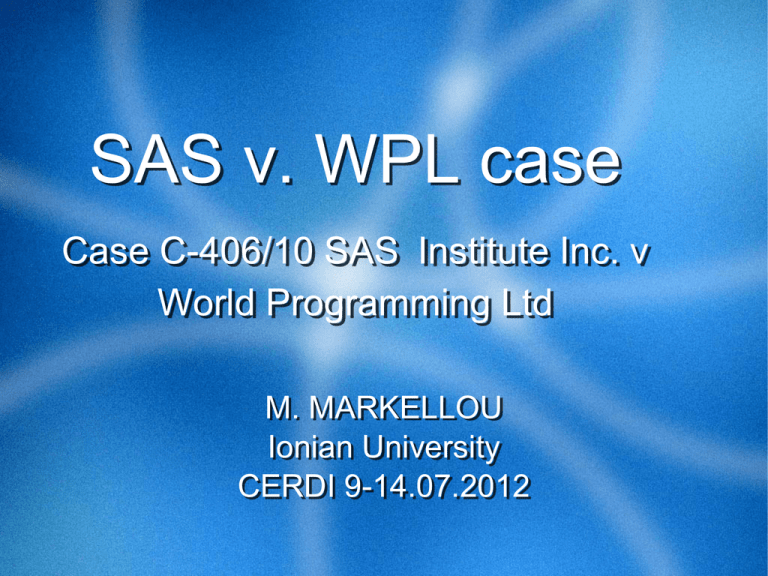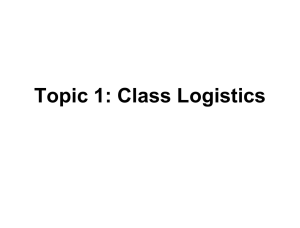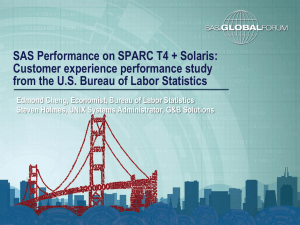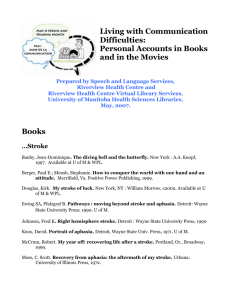SAS v. WPL case Case C-406/10 SAS Institute Inc. v World
advertisement

SAS v. WPL case Case C-406/10 SAS Institute Inc. v World Programming Ltd M. MARKELLOU Ionian University CERDI 9-14.07.2012 BACKGROUND SAS Institute developed a suite of integrated computer programs (SAS System) SAS System: users can write&run thein own scripts in the SAS programming language BACKGROUND WPL created a competing programme (WPS) WP System: SAS users could migrate their scripts to WPS, they could run them on WPL alternative interoperable platform SAS attacked WPL for CR infringement BACKGROUND The High Court of England & Wales referred more than 9 preliminary questions to the CJEU A fact : WPL had neither seen nor copied the source code of SAS components nor its structural design, and had not decompiled the SAS System's object code. QUESTION 1: the functionality of a computer program, its programming language and the format of its data files may constitute a form of expression of a computer program, and may therefore be protected by copyright under the Software Directive ? CJEU : No BUT they may be under InfoSoc Directive Point 35 : ” (..) the Court interpreted Article 1(2) of Directive 91/250 as meaning that the object of the protection conferred by that directive is the expression in any form of a computer program, such as the source code and the object code, which permits reproduction in different computer languages (judgment of 22 December 2010 in Case C-393/09 Bezpečnostní softwarová asociace [2010] ECR I-0000, paragraph 35)” Point 39 : ” (..) neither the functionality of a computer program nor the programming language and the format of data files used in a computer program in order to exploit certain of its functions constitute a form of expression of that program for the purposes of Article 1(2) of Directive 91/250.” Point 45 : “ The Court also points out that the finding made in paragraph 39 of the present judgment cannot affect the possibility that the SAS language and the format of SAS Institute’s data files might be protected, as works, by copyright under Directive 2001/29 if they are their author’s own intellectual creation (...)” QUESTION 2: a lawful user of a computer program may study, observe and test that program as long as he does not infringe the exclusive rights of the owner of the copyright in the program ? CJEU: Yes Point 61: “ It must therefore be held that the copyright in a computer program cannot be infringed where, as in the present case, the lawful acquirer of the licence did not have access to the source code of the computer program to which that licence relates, but merely studied, observed and tested that program in order to reproduce its functionality in a second program.” QUESTION 3: the reproduction, in a computer program or a user manual for that program, of certain elements described in an earlier user manual constitutes an infringement of the copyright in the earlier manual ? CJEU: It is for the national Court to determine this Point 66. “ In the present case, the keywords, syntax, commands and combinations of commands, options, defaults and iterations consist of words, figures or mathematical concepts which, considered in isolation, are not, as such, an intellectual creation of the author of the computer program.” Point 68 : “It is for the national court to ascertain whether the reproduction of those elements constitutes the reproduction of the expression of the intellectual creation of the author of the user manual for the computer program at issue in the main proceedings.” COMMENTS... What is a programming language ? A high – level language (C++, Java, RUBY …) A predefined set of commands (‘complex’ commands) A defined set of syntax rules for the execution of the program A functional tool which allows instructions to be given to the computer The means that permits expression to be given, not the expression itself COMMENTS... the CJEU does not clarify the situation by holding that a programming language is an element that is not eligible for CR protection under the Software Directive BUT it could be under the InfoSoc Directive …provided that the requirement of author’s own intellectual creation is fulfilled (Infopaq Case, Bezpečnostní softwarová asociace Case) Risque of creating a monopoly restrictions on interoperability Risque of undermining innovation and competition in the software industry









